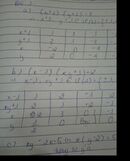
Hãy nhập câu hỏi của bạn vào đây, nếu là tài khoản VIP, bạn sẽ được ưu tiên trả lời.


BÀI 1:
\(3x+23\)\(⋮\)\(x+4\)
\(\Leftrightarrow\)\(3\left(x+4\right)+11\)\(⋮\)\(x+4\)
Ta thấy \(3\left(x+4\right)\)\(⋮\)\(x+4\)
nên \(11\)\(⋮\)\(x+4\)
hay \(x+4\)\(\inƯ\left(11\right)=\left\{\pm1;\pm11\right\}\)
Ta lập bảng sau
\(x+4\) \(-11\) \(-1\) \(1\) \(11\)
\(x\) \(-15\) \(-5\) \(-3\) \(7\)
Vậy \(x=\left\{-15;-5;-3;7\right\}\)
BÀI 2
\(\left(x+5\right)\left(y-3\right)=11\)
\(\Rightarrow\)\(x+5\) và \(y-3\) \(\inƯ\left(11\right)=\left\{\pm1;\pm11\right\}\)
Ta lập bảng sau:
\(x+5\) \(-11\) \(-1\) \(1\) \(11\)
\(x\) \(-16\) \(-6\) \(-4\) \(6\)
\(y-3\) \(-1\) \(-11\) \(11\) \(1\)
\(y\) \(2\) \(-8\) \(14\) \(4\)
Vậy.....
bài 1:
3x + 23 chia hết cho x + 4
ta có: 3x + 23 chia hết cho x + 4
mà x + 4 chia hết cho x + 4
=> 3(x + 4) chia hết cho x + 4
=> (3x + 23) - 3(x + 4) chia hết cho x + 4
3x + 23 - 3x - 12 chia hết cho x + 4
=> 11 chia hết cho x + 4
=> x + 4 thuộc Ư(11)
mà Ư(11)= {-11;-1;1;11}
=> x + 4 thuộc {-11;-1;1;11}
=> x thuộc {-15;-5;-3;7}
Vậy x thuộc {-15;-5;-3;7} thì 3x + 23 chia hết cho x + 4
bài 2:
(x + 5).(y-3) = 11
ta có bảng:
x + 5 -11 -1 1 11
y - 3 -1 -11 11 1
x -16 -6 -4 6
y 2 -8 14 4
vậy (x,y) thuộc {(-16;2);(-6;-8);(-4;14);(6;40} thì (x + 5).(y - 3) = 11
Chúc bạn học giỏi ^^

a )
(x-3).(2y+1)=7
(x-3).(2y+1)= 1.7 = (-1).(-7)
Cứ cho x - 3 = 1 => x= 4
2y + 1 = 7 => y = 3
Tiếp x - 3 = 7 => x = 10
2y + 1 = 1 => y = 0
x-3 = -1 ...
1.tìm các số nguyên x và y sao cho:
(x-3).(2y+1)=7
Vì x;y là số nguyên =>x-3 ; 2y+1 là số nguyên
=>x-3 ; 2y+1 C Ư(7)
ta có bảng:
| x-3 | 1 | 7 | -1 | -7 |
| 2y+1 | 7 | 1 | -7 | -1 |
| x | 4 | 10 | 2 | -4 |
| y | 3 | 0 | -4 | -1 |
Vậy..............................................................................
2.tìm các số nguyên x và y sao cho:
xy+3x-2y=11
x.(y+3)-2y=11
x.(y+3)-y=11
x.(y+3)-(y+3)=11
(x-1)(y+3)=11
Vì x;y là số nguyên => x-1;y+3 là số nguyên
=> x-1;y+3 Thuộc Ư(11)
Ta có bảng:
| x-1 | 1 | 11 | -1 | -11 |
| y+3 | 11 | 1 | -11 | -1 |
| x | 2 | 12 | 0 | -10 |
| y | 8 | -2 | -14 | -4 |
Vậy.......................................................................................

\(a,\Leftrightarrow y\left(x+1\right)-3\left(x+1\right)=5\\ \Leftrightarrow\left(x+1\right)\left(y-3\right)=5=5.1=\left(-5\right)\left(-1\right)\\ TH_1:\left\{{}\begin{matrix}x+1=1\\y-3=5\end{matrix}\right.\Leftrightarrow\left\{{}\begin{matrix}x=0\\y=8\end{matrix}\right.\\ TH_2:\left\{{}\begin{matrix}x+1=5\\y-3=1\end{matrix}\right.\Leftrightarrow\left\{{}\begin{matrix}x=4\\y=4\end{matrix}\right.\\ TH_3:\left\{{}\begin{matrix}x+1=-5\\y-3=-1\end{matrix}\right.\Leftrightarrow\left\{{}\begin{matrix}x=-6\\y=2\end{matrix}\right.\\ TH_4:\left\{{}\begin{matrix}x+1=-1\\y-3=-5\end{matrix}\right.\Leftrightarrow\left\{{}\begin{matrix}x=-2\\y=-2\end{matrix}\right.\)
Vậy \(\left(x;y\right)\in\left\{\left(0;8\right);\left(4;4\right);\left(-6;2\right);\left(-2;-2\right)\right\}\)
\(b,\Leftrightarrow6\left(n-1\right)+11⋮n-1\\ \Leftrightarrow n-1\in\left\{-11;-1;1;11\right\}\\ \Leftrightarrow n\in\left\{-10;0;2;12\right\}\)

\(a)\)
\(\left(x+3\right)\left(y+1\right)=3=1.3=\left(-1\right).\left(-3\right)\)
Ta có bảng sau:
| \(x+3\) | \(1\) | \(-1\) | \(3\) | \(-3\) |
| \(y+1\) | \(3\) | \(-3\) | \(1\) | \(-1\) |
| \(x\) | \(-2\) | \(-4\) | \(0\) | \(-6\) |
| \(y\) | \(2\) | \(-4\) | \(0\) | \(-2\) |
Vậy ...
\(b)\)
\(\left(x-1\right)\left(xy+1\right)=2=1.2=\left(-1\right).\left(-2\right)\)
Ta có bảng sau:
| \(x-1\) | \(1\) | \(-1\) | \(2\) | \(-2\) |
| \(xy+1\) | \(2\) | \(-1\) | \(1\) | \(-1\) |
| \(x\) | \(2\) | \(0\) | \(3\) | \(-1\) |
| \(y\) | \(\frac{1}{2}\) | Loại | \(0\) | \(2\) |
Vậy ...
\(c)\)
\(xy-2=5\)
\(\Leftrightarrow x\left(y-2\right)=5=1.5=\left(-1\right).\left(-5\right)\)
Ta có bảng sau:
| \(x\) | \(1\) | \(-1\) | \(5\) | \(-5\) |
| \(y-2\) | \(5\) | \(-5\) | \(1\) | \(-1\) |
| \(y\) | \(7\) | \(-3\) | \(3\) | \(1\) |
Vậy ...

4:
(x+1)(y-2)=5
=>\(\left(x+1;y-2\right)\in\left\{\left(1;5\right);\left(5;1\right);\left(-1;-5\right);\left(-5;-1\right)\right\}\)
=>\(\left(x,y\right)\in\left\{\left(0;7\right);\left(4;3\right);\left(-2;-3\right);\left(-6;1\right)\right\}\)

\(a.x=1;y=9\)
\(b. (x-6). (y+2)=7\)
Ta lập bảng :
| \(x-6\) | \(1\) | \(-1\) | \(7\) | \(-7\) |
| \(y+2\) | \(7\) | \(-7\) | \(1\) | \(-1\) |
| \(x \) | \(7\) | \(5\) | \(13\) | \(-1\) |
| \(y\) | \(5\) | \(-9\) | \(-1\) | \(-3\) |
\(Vậy :..........\)
a) Vì x, y nguyên mà x.y = 9 nên x, y thuộc Ư(9)
Mà x< y. Ta có bảng sau
| x | 1 | -9 |
| y | 9 | -1 |
Vậy (x,y) \(\in\){(1;9) , ( -9; -1) }
b) vì x, y nguyên suy ra x-6 , y + 2 nguyên
mà (x-6). ( y+2) =7
nên (x-6), ( y+2) thuộc Ư(7) .Ta lập bảng như sau
| x-6 | 1 | -1 | 7 | -7 |
| y+2 | 7 | -7 | 1 | -1 |
| x | 7 | 5 | 13 | -1 |
| y | 5 | -9 | -1 | -3 |
Tự kết luận nhé

\(xy-y+y=5\\ \Leftrightarrow xy=5\)
Mà x,y∈Z⇒x,y∈Ư(5)\(\Rightarrow\left(x,y\right)\in\left\{\left(1;5\right);\left(5;1\right);\left(-1;-5\right);\left(-5;-1\right)\right\}\)
thanks